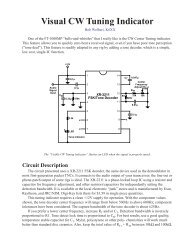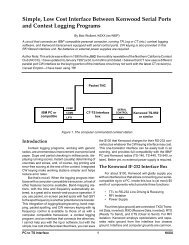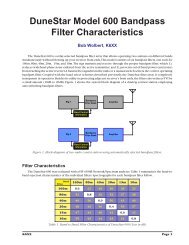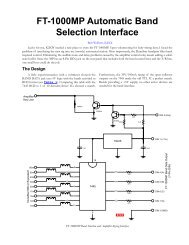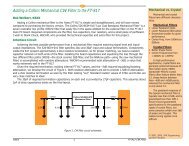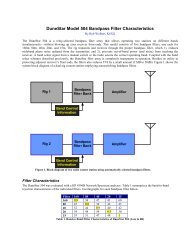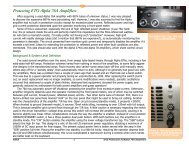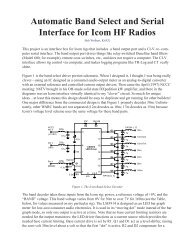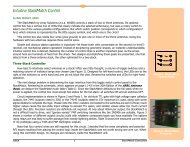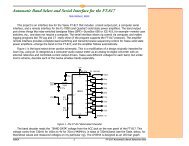Yaesu FT-857 Quirks - K6xx.com
Yaesu FT-857 Quirks - K6xx.com
Yaesu FT-857 Quirks - K6xx.com
Create successful ePaper yourself
Turn your PDF publications into a flip-book with our unique Google optimized e-Paper software.
<strong>Yaesu</strong> <strong>FT</strong>-<strong>857</strong> <strong>Quirks</strong><br />
The <strong>Yaesu</strong> <strong>FT</strong>-<strong>857</strong> has a number of “undocumented features”, some of which are very interesting. In no<br />
particular order, here are my favorite quirks.<br />
XX Holding FAST for one second on the supplied microphone will toggle power.<br />
XX The small wire on the power supply connector simulates the <strong>FT</strong>-897’s internal battery sense line. When this<br />
wire is grounded, the <strong>FT</strong>-<strong>857</strong> operation changes subtly. With the display backlight in AUTO 2 (the default)<br />
and the sense wire grounded, the display light extinguishes after about three seconds, identically to AUTO 1<br />
mode. Also, the supply current drawn by the rig when it is turned OFF drops from about 8mA to about<br />
2.5mA.<br />
XX The KEY jack has ALC on the tip and either TXREQ (Transmit Request) or TX GND (amplifier key-line driver)<br />
on the ring. A jumper inside the rig selects between the two. TX REQ provides full QSK keying when<br />
grounded, but no sidetone. The relay chatters like mad!<br />
XX The microphone connector provides serial control capability (CAT) if Menu 059 is changed from NOR to CAT<br />
and a simple interface cable is constructed (see Using the <strong>FT</strong>-<strong>857</strong> Microphone Jack for Serial<br />
Control).<br />
XX When the rear panel CAT/Linear jack is set to LIN mode (Menu 020), four bit band data is available for<br />
controlling an auto-band switching amplifier, band pass filters, or automatic antenna selections matrices. The<br />
band codes are shown in the following table (in volts):<br />
Band D C B A<br />
160 0 0 0 5<br />
80 0 0 5 0<br />
60 0 0 5 5<br />
40 0 0 5 5<br />
30 0 5 0 0<br />
20 0 5 0 5<br />
17 0 5 5 0<br />
15 0 5 5 5<br />
12 5 0 0 0<br />
10 5 0 0 5<br />
6 5 0 5 0<br />
2 5 0 5 5<br />
440MHz 5 5 0 0<br />
NCCC<br />
Note there is no provisions for the 222MHz band in this scheme, and 60m shares its code with 40m.<br />
XX<br />
When the IPO is engaged, turning OFF the preamplifier, supply current INCREASES by about 10mA(!).<br />
K6XX 1 <strong>FT</strong>-<strong>857</strong> “<strong>Quirks</strong>”<br />
© 2005, 26K Engineering and<br />
R.P. Wolbert
NCCC<br />
XX<br />
The optional filters have a coding embedded on their PC boards. This code tells the <strong>FT</strong>-<strong>857</strong>’s controller<br />
whether a filter is installed in either or both of the slots and its bandwidth. The rig responds by changing the<br />
text on the filter select menu (multi-function row N) and adjusting the BFO injection frequency. Filters<br />
without this coding may require use of IF Shift to center the passband. The code for each of the three <strong>Yaesu</strong><br />
optional filters is shown below, with 1 = open circuit and 0 = ground:<br />
ODF2 OFD1 OFD0 Filter<br />
1 0 0 300Hz<br />
1 0 1 500Hz<br />
1 1 0 2.3kHz<br />
<br />
CW Filter Coding<br />
<br />
<br />
<br />
All other <strong>com</strong>binations are apparently ignored. See the sidebar for drawings.<br />
<br />
Miscellaneous Positive Opinions<br />
XX Three user-programmable soft keys are available<br />
XX Internal CW keyer speed may be controlled by a front panel knob (SEL) instead of only via menu. OR,<br />
output power may be adjusted using this control (but not both). There are other choices as well.<br />
XX VOX may be separately activated for the DATA jack. Thus, PSK31 (etc.) cabling may be greatly simplified.<br />
XX There is an analog meter output provided on the faceplate. This meter can show several parameters both in<br />
receive and in transmit.<br />
Miscellaneous Negative Opinions<br />
<br />
<br />
<br />
<br />
<br />
<br />
<br />
XX<br />
XX<br />
XX<br />
The RIT Clear is too strange and awkward to be useful<br />
CW pitch steps of 100 Hz are too coarse<br />
Suffers from the same strong in-band birdies as the <strong>FT</strong>-817 (look at 7240 for example). IF shift is not as<br />
effective in cancelling out these birdies, and the DSP notch filter doesn’t kill them <strong>com</strong>pletely either.<br />
Rev 1.01. 2 March 2005<br />
K6XX 2 <strong>FT</strong>-<strong>857</strong> “<strong>Quirks</strong>”<br />
© 2005, 26K Engineering and<br />
R.P. Wolbert




